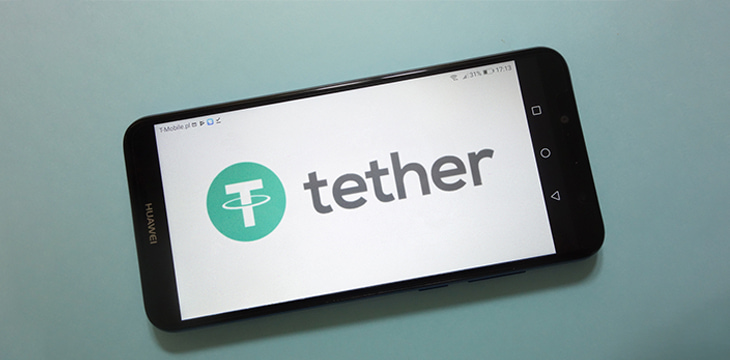|
Getting your Trinity Audio player ready...
|
Tether’s top execs appear increasingly agitated as prominent mainstream media outlets sharpen their focus on the stablecoin’s alleged reserves.
This week, the Wall Street Journal published an article expressing doubt over Tether’s claims that it has sufficient reserves to back the over $65 billion worth of its USDT stablecoin currently out there in the wild. Specifically, the WSJ expressed concern over Tether’s willingness to loan USDT to exchanges and market-makers that provide sketchy tokens as collateral instead of selling USDT for USD, as the company claims is the standard operating procedure.
Tether’s most recent legally compelled attestation of its reserves—despite repeated promises, the company has never submitted to a third-party audit—shows $6.1 billion in ‘secured loans’ as of September 30. That’s $2 billion more than Tether had loaned out at the end of last year and currently represents 9% of total USDT issued, up from 5% as of December 31, 2021.
Tether spokesperson Alex Welch insisted that only “eligible clients are borrowing USDT” and that these loans are “overcollateralized by extremely liquid assets that Tether’s prudent risk management admits as collateral.”
But Tether’s willingness to loan out USDT conflicts with the company’s previous statements that it “only issues new tether tokens when they are requested and purchased by customers.” (Emphasis added.) And Welch declined to specify whether any of the assets backing these loans were ‘crypto’ tokens, many of which have seen their value plummet this year and thus may no longer be sufficient to cover the value of the loaned USDT.
Welch also failed to clarify whether any of Tether’s loans were made to related parties. Tether’s attestations formerly stated that affiliated parties weren’t holding any loaned USDT, but this detail was omitted earlier this year, and Welch declined to offer any explanation for the change.
Really into pegging
The WSJ also expressed concern over the $2.6 billion in ‘other investments’ listed on Tether’s latest attestation. That’s half the value cited at the end of 2021, perhaps a reflection of the dramatic plunge in the value of most tokens following the onset of the current ‘crypto winter.’
Tether claims to have around $250 million in assets over and above the total sum of issued USDT as of September 30, a ‘capital cushion’ of about 0.4%. But USDT has been known to lose its 1:1 peg with the U.S. dollar during times of market volatility, as on May 12, when USDT fell to 95.6¢ on the dollar (as low as 92¢ on some exchanges).
That depegging event, like others before it, has been fairly brief. But should USDT suffer a sustained loss of its peg, the value of Tether’s USDT-denominated loans would mean its reserves’ cushion’ would be insufficient to meet its obligations during a flood of USDT redemption requests.
Of course, Tether’s own Terms of Service cites that you have to be a “verified customer of Tether” to redeem USDT, which leaves retail investors holding USDT on an exchange completely out of luck. Even for its ‘verified’ customers, Tether “makes no representations or warranties about whether Tether Tokens that may be traded on the Site may be traded on the Site at any point in the future, if at all.”
The fact that Tether’s cushion is only $250 million is all the more incredulous given the company’s loudly proclaimed transformation of the bulk of its reserve assets from sketchy products that were absolutely-not-worthless-commercial-paper from sketchy Chinese real estate firms into rock-solid U.S. Treasury bills.
While the yield on T-bills had been pitifully small for years, they have been on a steadily upward trajectory for nearly three years now, and the 10-year bills currently offer a not-too-shabby 3.7% return. The yield on short-term T-bills—the kind Tether claims to hold—is even higher.
And yet, Tether—which now claims to hold just under $40 billion worth of T-bills, twice the sum reported as of September 30, 2021—seems to have derived little to no financial benefit whatsoever from these generous yields. It’s almost as if that Bloomberg report from October 2021—the one that failed to find a single Wall Street trader who’d ever heard of Tether making any significant T-bill purchases—was on to something.
There’s also Tether’s repeated claims to have managed to exit every single crypto crash—like the Ponzi scheme formerly known as Celsius, in which Tether was a significant investor and provided nearly $1 billion in loans—without so much as one lost dollar was, you know, so much hogwash.
Excellent…
The WSJ report came up during an appearance by Tether co-founder Reeve Collins on CNBC’s Squawk Box program on Friday. Host Andrew Sorkin pressed Reeves about why the company couldn’t provide the public with a proper, independent, third-party audit of Tether’s reserves.
Reeves claimed that Tether did offer proof of its reserves via its half-assed attestations, which he falsely characterized as audits. Pressed by Sorkin whether enhanced regulatory scrutiny meant Tether would be “forced to disclose exactly what backs these assets,” Reeves said only that “we’ll see how these regulations [currently under discussion in the U.S. Congress] play out.”
Reeves—who sold his stake in the firm he co-founded years ago, likely because he hoped to stay out of jail—proceeded to claim that “our industry has done an excellent job of self-policing.” The fact that Reeves was able to say that with a straight face suggests he and Jon Lovitz may have been separated at birth.
No, you’re fat!
A sharper response came from Tether’s official site through an uncredited blog post titled WSJ & CO: The Hypocrisy of Mainstream Media, Asleep at the Wheel of Information. The lengthy post doesn’t actually address the WSJ article until nearly the end, spending most of the proceeding copy excoriating all of Tether’s critics for allegedly being “asleep at the wheel” before the current crypto winter became an ice age.
When it finally gets around to the WSJ, the post claims the article “had many misconceptions” regarding Tether’s loans because it “mistakes the USDT itself for the collateral that underpins it. Tether’s secured loans are extremely overcollateralized and even backstopped by Tether’s additional equity if needed.”
Also, “a decline in the price of USDT tokens is immaterial since these declines only reflect exchange value and not redemption value for the underlying collateral.” However, the WSJ correctly noted that nearly all tokens had suffered significant declines this year, so, regardless of any sustained depeg, the redemption value of the assets pledged as collateral for Tether’s billions in loans may not be worth anywhere near their book value.
Martyrdom is delicious
But the gist of Tether’s jeremiad is that the company has been unfairly singled out for criticism when compared to the glowing media profiles of FTX and its fuzzy-headed/helium-voiced CEO Sam Bankman-Fried before the exchange and its affiliated market-maker Alameda Research filed for bankruptcy protection last month.
Some of that criticism may be fair—although you’ll find plenty of SBF skepticism on this site long before the present debacle commenced—but it’s a bit rich for Tether to crap on Alameda, given that it was among the largest recipients ($36 billion as of September 2021) of USDT.
If anyone appeared willing to treat SBF as a rainbow-farting hero, it was Tether for not showing any curiosity whatsoever as to where exactly that $36 billion (and billions more after that) came from. And keep in mind that requires us to swallow the fiction that Alameda was actually sending tens of billions in actual dollars to Tether, despite scant evidence that FTX/Alameda ever had access to that kind of cash.
Tether’s usual public faces, CTO Paolo Ardoino and general counsel Stuart Hoegner, conducted a disastrous interview on CNBC in July 2021 that they’ve yet to repeat, likely because their hand-wavey answers weren’t enough to dissuade host Dierdre Bosa from probing the pair on Tether’s reserves. But Paolo did manage to keep it together long enough to explain that Tether’s big bosses Giancarlo Devasini and Jean Louis van der Velde, didn’t do interviews because they were too busy pampering big clients—like Alameda’s then-CEO Sam Trabucco.
We’d be remiss if we didn’t point out that, to support its contentions, Tether’s article cites multiple links to articles written by none other than Arthur Hayes, the disgraced former CEO of the BitMEX exchange, who earlier this year paid $10 million to avoid a jail sentence for violating the U.S. Bank Secrecy Act. Birds of a feather…
Follow CoinGeek’s Crypto Crime Cartel series, which delves into the stream of groups—from BitMEX to Binance, Bitcoin.com, Blockstream, ShapeShift, Coinbase, Ripple,
Ethereum, FTX and Tether—who have co-opted the digital asset revolution and turned the industry into a minefield for naïve (and even experienced) players in the market.

 12-24-2025
12-24-2025 




